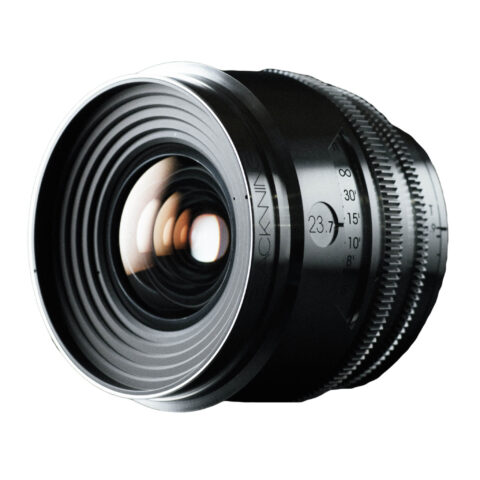
TRIBE7 introduces a limited run of Second Edition BLACKWING7 Binary Prime Lenses. This release builds on the legacy of the original prototypical Binary lenses, introduced five years ago. 10 sets were made in 2019 as test and evaluation optics.
The original all-chrome BLACKWING7 Binary design included creative analog artifacts such as spherical aberration and halation and had very distinctive flare characteristics. These lenses helped to establish the optical prescriptions forseries production and allowed TRIBE7 to explore fundamentals of look variation through proprietary lens coating and un-coating, culminating in the S, T and X standard production lenses released for sale in 2020.
Neil Fanthom, co-founder and CEO of TRIBE7, explains:
Early in 2019, the BLACKWING7 program was entirely experimental, and honestly the prospect of creating an entirely new range of lenses, from scratch, having vintage characteristics blended with modern mechanics and processes was going well against the industry grain. And the startup capital that TRIBE7 was able to access only gave us one chance.
Binary in the context of the BLACKWING7 program represented two states—light and dark, of course, which seemed appropriate for the lenses—but also a hard nod to the program risk. On or Off, Pass or Fail.
Binary lenses have been—and continue to be—used on high-end film and TV productions by Cinematographers such as Darius Khondji, ASC, AFC; Matthew Libatique, ASC; Chung-Hoon Chung; Matthew J. Lloyd, ASC; Bobby Bukowski ASC; and Jason McCormick.
We got a lot of feedback from DPs on the original look of the Binaries. And so, we re-tuned and optimized those lenses over time, but always kept a level of modularity in our back pocket to allow the look of the first-run prototypes to be re-created if ever needed.
The new Second Edition BLACKWING7 Binaries pay complete homage to their prototypical predecessors, while offering filmmakers greater creative control through new modular components such as custom-tuned optics, flare control systems and the SKIN program of alternative coatings for BLACKWING7 front lens elements.
Due to the very limited release of the Second Edition Binary run, a modest number of rental companies and Cinematographers, who have been with us since the start, were offered the lenses on a first refusal basis as a kind of thank you for keeping the faith. However, one large client we’ve developed a strong relationship with over the years has invested heavily in the new build, and is taking multiple sets. They’ll help guide our lens tuning program in the coming years, for sure.
BLACKWING7 primes are inherently multi-format lenses, originally designed to fully cover 65mm imaging systems such as the ARRI ALEXA 65, Blackmagic 17K 65mm Cine Camera, Fujifilm GFX100 II as well as Panavision System 65 and Arriflex 765 65mm format film cameras. Allowing for safety and with a 2.39:1 extraction, depending on the image canvas—all our lenses from 17mm to 137mm will illuminate, and for the largest canvas (ALEXA 65) the 27 to 137mm primes will illuminate.
We also kept an eye on how the Blackwings performed in Super35, Full Frame and up—to make sure that customers who invested in our lenses could use them across all cameras, in all formats. Essentially, we wanted the lenses to be future-proof for all camera and capture technologies, no matter the format or recording medium. Our lens design andmanufacturing partner IB/E Optics totally supported this concept.
The larger the format, the more expression you’ll see in our lenses, and TRIBE7 sees the rise of 65 playing a big partin filmmaking, with accessibility to 65mm capture being democratized and an option on the horizon for many more productions.
TRIBE7 is committed to rounding out the BLACKWING7 spherical lens program with additional wide focal lengths. The 20.7mm and 23.7mm Binaries were made in 2020 and 2022, and the new 17mm T1.9 is in development now. All of our new wide-angle lenses are designed to extend the BLACKWING7 focal length range to cover formats from Super35 to Full Frame (Large Format) and into 65mm.
Original 65mm analog film image dimensions are around 43mm wide x 22.5mm high (48.53mm diagonal). Arriflex 765 analog film camera is 52.5 x 23.0 mm (57 mm diagonal). ALEXA 65 is 54.12 x 25.58 mm (diagonal 59.86 mm). Fujifilm GFX100 II is 43.8 x 32.9 mm (54.78mm diagonal). Blackmagic URSA Cine 17K 65mm is 50.808 x 23.316mm (55.9mm diagonal).
We’ll also extend our lens tuning capabilities with access for owner-operators and rental companies alike. We believe that lens tuning is the future. Tuning lenses you know and trust just makes sense and is a skill most rental companieseither have or are developing.
TRIBE7 is committed to spherical optics.
Neil continues:
Co-founder and CEO Bradford Young, ASC and I had considered an anamorphic lens program a few years ago but choosing which capture format (Super35, Full Frame, 65mm), and which lens squeeze (1.3, 1.5, 1.65, 1.8, 2.0) to choose was frustratingly complicated. It’s not possible to create small, light, fast and reasonably-priced multi-format anamorphic primes with variable squeeze factors, otherwise we’d have done it.
Also, some of the largest rental companies have poured a creative lifetime on anamorphic lens leadership. They are best placed to drive the future of anamorphic capture and we respect and admire their influence and legacy.








Hi jon
Seems like a meaningful improvement to the art of cinematography
Hope all is well?
CU at Cinegear ?
Maybe we can plan a dinner ?
Cheers !
Yes–see you at Cine Gear.
I am glad that Neil keeps the philosophy on the TRIBE7 project clear and straight. We at IB(E optics are happy to be part of that successful story creating lenses from design to production for the 65mm format.